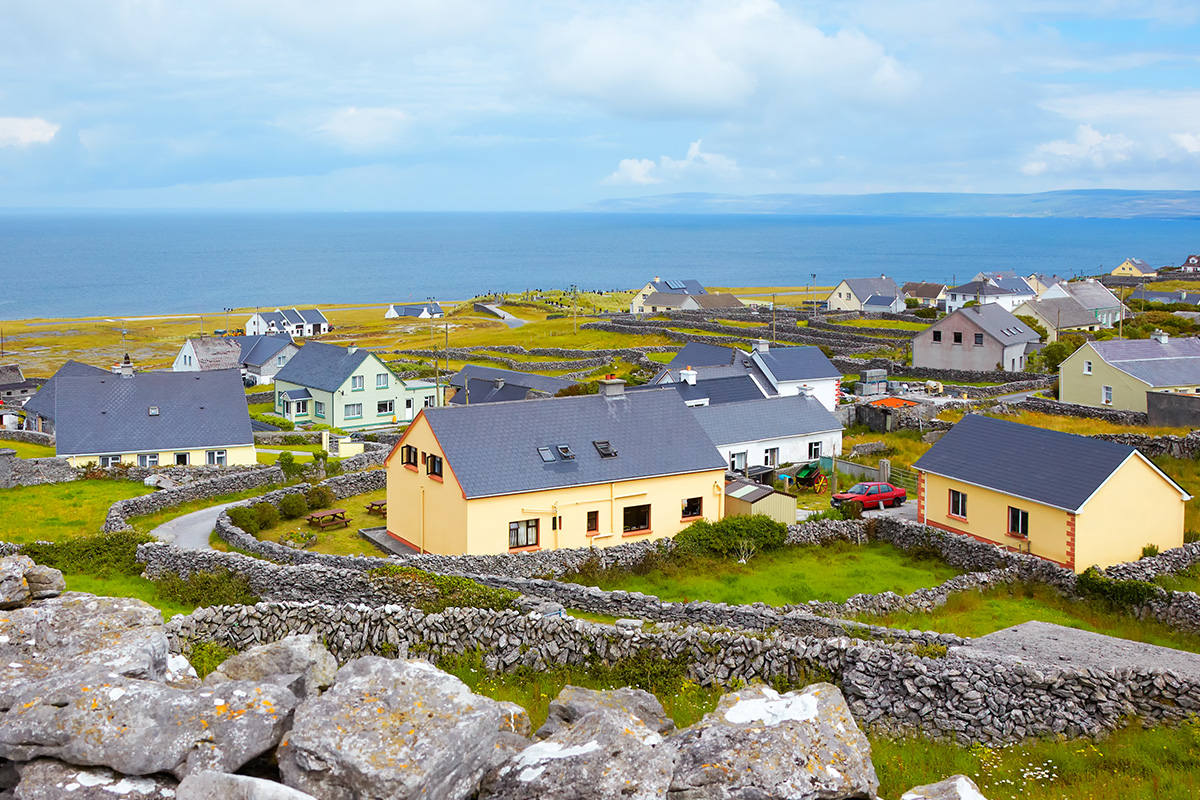The Aran Islands | County Galway | Ireland

Area: 46km² (18mi²)
Population: 1200
Having made many trips to Ireland, one of the most common questions I receive on a trip is,
“How many islands are there in Ireland.”
About 80 in total, of which only about one-quarter are inhabited. One of the most famous, and for me the most impressive, are the Aran Islands in county Galway. The Aran Islands, or the Arans as many calls them, are a group of three islands located on the west coast of Ireland near the town of Galway. They are accessible by ferry from Rossaveal in Co. Galway, Doolin in Co. Clare, or flights from Inverin in Co. Galway.
What are the Aran Islands?
The islands are from the east, Inishmore, the largest, and Inishmaan and Inisheer, the smallest. There are also several islets and small uninhabited islands within the group. Collectively they have over 1200 people who primarily speak the Irish language, but almost everyone is fluent in English.
However, the island’s population has been steadily declining for nearly 200 years. In 1841, the population exceeded 3500, but many left due to famine, lack of work, or the search for a better life.
Gaeltacht
Within Ireland, there are several areas where the Irish language is predominant over English. These areas, or districts, are collectively known as Gaeltacht. These areas are primarily on the west coast and include County Donegal, Galway, Mayo, and Kerry and County Waterford in the southeast.
The Irish language has been steadily declining for almost 200 years, with only 2% of the population using it regularly. More recently, the Irish government has attempted to re-establish Irish-speaking communities through schools, colleges, and universities.


Geology
The islands are mainly limestone karst, like the Burren in County Clare, and are undulating lowlands with no significant mountains or hills. However, on the western side of Inishmore and Inishmaan, the land rises high enough to create dramatic cliffs over the Atlantic.
History
Little is known of the original inhabitants; however, it is widely assumed they located there to either hide or be able to defend themselves from attack. Back then, farming was a little easier to pursue on the islands than on the densely forested mainland. With that being said, the islands are not particularly appealing for habitation as they are primarily made of limestone and so have very little naturally occurring topsoil.
Early settlers attempted to correct this by using seaweed and sand from the shoreline to augment the soil. To protect this, drystone walls were built, which today are one of the features of the islands.
Archaeologists have discovered at least seven prehistoric stone forts, with the oldest one, Dún Aonghasa on Inishmore, dating back to 1100BC.

Irish Saints
Saint Enda of Aran was a warrior King from Ulster who was converted to Christianity by his sister Saint Franchea. In the late 5th century, he established his first monastery at Killeany on Aran Mor. Over the following years, it, along with the islands, became a centre for learning, piety, and religious pursuit.
By the time Strongbow, the Earl of Pembroke, arrived in Ireland in the 12th century, there were more than a dozen such monasteries. Saint Enda is today considered the patriarch of Irish monasticism. As a result, most great Irish saints have a connection with the islands, including St. Brendan, Jarlath of Tuam, Finnian of Clonard and St. Columba. Today, the islands contain 38 national monuments, most of them involve religion.
Several well-known structures remain from this period, including the 5th century Church of Saint Brecan and a prehistoric ring fort on Inisheer called Dún Formna, which would later be the site of O’Brien’s castle in the 14th century. From the 14th century onwards, control of the islands was disputed between two Gaelic families, the O’Brien’s and the O’Flaherty’s.


Oliver Cromwell and destruction
Unfortunately, many of these ancient sites were destroyed by Oliver Cromwell in the 17th century in the wars as he attempted to destroy Irish history and culture. Today, of the seven churches established by Saint Brecan, only two have survived.
Also found on the islands are clocháns, dry-stone beehive huts that were used by early Christians for meditation and prayer.
A typical settlement on the islands was known as a clachan, a cluster of tiny single-story houses with thatched roofs.
Aran Sweaters and Aran Dress
Many residents developed a style of clothing based on homespun materials such as tweed and wool. Even today, the islands have an outstanding reputation for the quality of their clothing and the cream-coloured knitted Aran sweaters.
Until the 1930s, many people on the island wore these garments, which became known as the Aran dress. These included bright red skirts and black shawls for the women, baggy woollen trousers and waistcoats made of grey or light-brown tweed with a colourful belt (crios) for the men.

John Milton Synge
At the end of the 19th century, the Irish writer John Milton Synge started spending his summer on the Aran Islands. He is best known for his play, The Playboy of the Western World. His 1904 play, Riders to the Sea, is set in Inishmaan. In 1907, he also published The Aran Islands, a series of short stories based on his journals written whilst on the islands.
Are the Aran islands worth seeing?
For anyone visiting County Galway, the Aran Islands are undoubtedly worth a visit. A combination of spectacular scenery, a rich history, and excellent local products make the islands a wonderful excursion.
A visit to the Aran Islands is included on Highlights of Ireland by bwd Vacations and several itineraries by Insight Vacations, Trafalgar, Cost Saver, and Luxury Gold.





